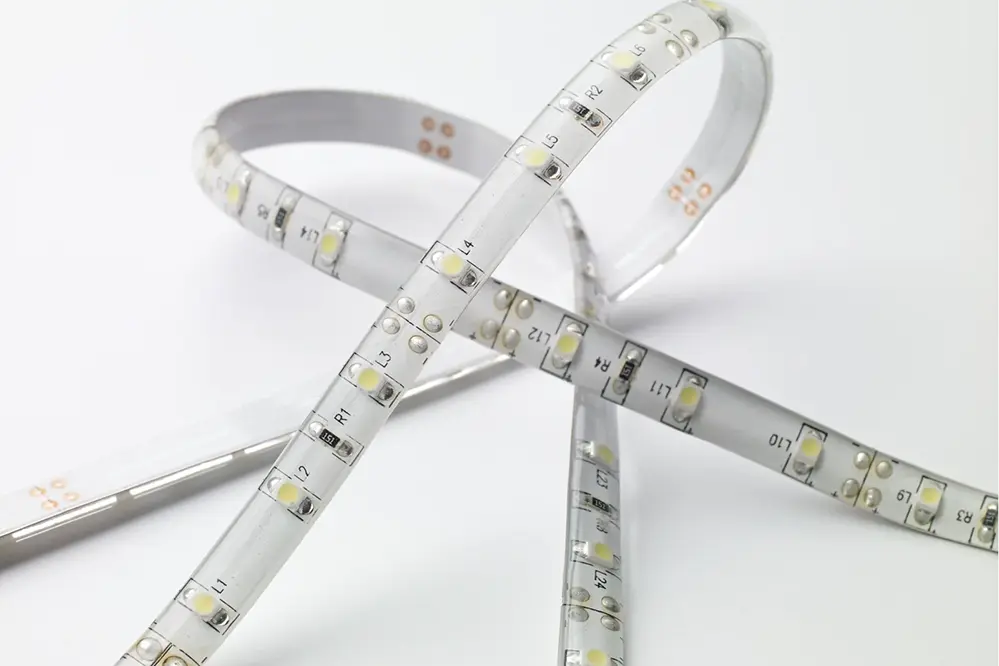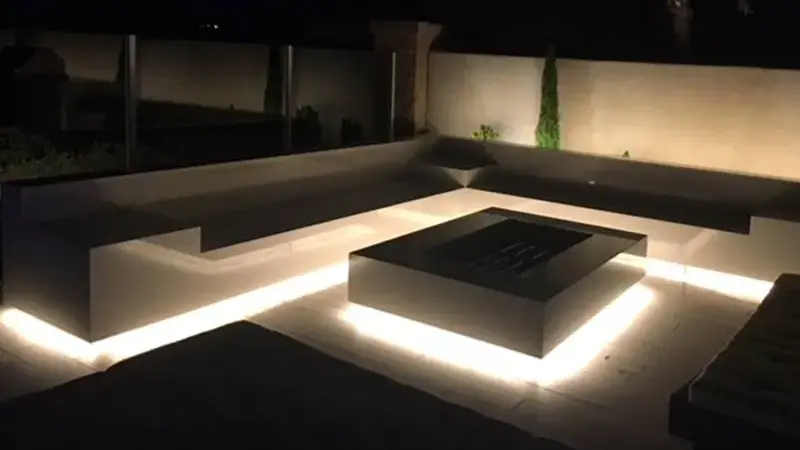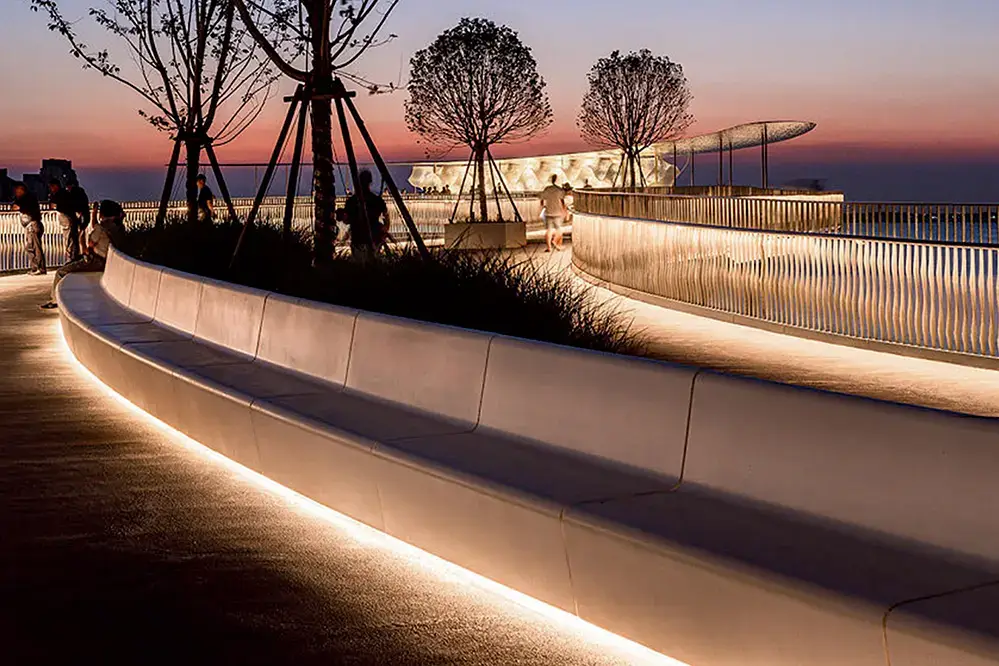In the ever-evolving world of LED lighting, choosing the right waterproof material, such as silicone, for your LED strip lights can make all the difference. Whether you’re a lighting enthusiast or a professional, understanding the nuances between silicon waterproof and epoxy resin glue LED strip lights is crucial. These materials not only affect the longevity and performance of your lights but also their suitability for various environments. In this blog post, we’ll delve into a detailed comparison of these two popular waterproofing options, helping you make an informed decision for your next lighting project.
LED strip lights have revolutionized the way we illuminate spaces, offering flexibility, efficiency, and aesthetic appeal. However, the choice of waterproofing material can significantly impact their durability and functionality. Silicon glue and epoxy resin glue are two of the most commonly used materials in the market today. Each has its own set of advantages and drawbacks, which we’ll explore in depth. By the end of this article, you’ll have a clear understanding of which material, be it silicone or epoxy resin, is better suited for your specific needs.
My name is Tom, and I’ve been immersed in the LED lighting industry since 2005. Over the years, I’ve gained extensive knowledge about LED lighting technology, particularly LED tape strip lights. This blog post is a culmination of my experience and research, aimed at providing you with valuable insights into the world of LED strip light waterproofing. My goal is to equip you with the information you need to make the best choice for your lighting projects.
So, if you’re ready to discover the key differences between silicon waterproof and epoxy resin glue LED strip lights, let’s dive right in! This comprehensive guide will help you navigate the complexities of LED strip light waterproofing, ensuring you choose the right material for optimal brightness, performance, and longevity.
Introduction to Waterproof LED Strip Lights

Waterproof LED strip lights, celebrated for their versatility and the option of silicone material, have revolutionized both residential and commercial design.
For discerning consumers, choosing silicone or other waterproof materials is a paramount decision that significantly impacts performance and longevity. Among the commonly used materials are silicon glue, polyurethane (PU) glue, and epoxy resin glue. Each offers unique properties; thus, understanding these differences is crucial for making informed choices in various environmental conditions.
Epoxy resin glue, while cost-effective, presents notable drawbacks. It struggles with heat dissipation and tends to yellow over a short period. Moreover, its rigidity in cold temperatures reduces its reliability in colder climates, making it a less durable option.
Conversely, silicone glue exemplifies superior performance, environmental friendliness, and excellent heat dissipation capabilities. It withstands a wide temperature range from -20℃ to 50℃, ensuring durability and consistent performance. This exceptional resilience makes silicon glue the preferred choice for high-quality waterproof LED strip lights, ensuring longevity and satisfactory outcomes.
The Market for Waterproof Materials in LED Strips
The market for waterproof materials in LED strips has seen significant evolution over recent years. It caters to a variety of applications, ranging from residential to commercial purposes.
As of 2023, epoxy resin glue remains popular due to its affordability, despite its limitations in durability and performance. Its widespread use is driven by cost-sensitive markets prioritizing budget-friendly solutions over long-term sustainability.
Polyurethane (PU) glue has gained traction mainly for its enhanced resistance to yellowing and better adaptability in lower temperatures. However, concerns about its environmental impact and health implications have yet to be fully addressed.
In contrast, outdoor silicon waterproof LED strip lights have become the gold standard, admired for their robustness and eco-friendly attributes. They excel in various environments, reinforcing their status as the top choice for consumers demanding high quality.
The choice between these materials ultimately depends on the specific needs and priorities of each project, whether cost efficiency, performance, or environmental responsibility.
Overview of Epoxy Resin Glue LED Strip Lights
Epoxy resin glue LED strip lights are lauded for their cost-effectiveness, making them an attractive option for budget-conscious applications. However, they face significant drawbacks in heat dissipation, yellowing, and poor performance in extreme temperatures, leading to limited longevity and restrained flexibility in colder environments. Despite these limitations, their affordability ensures a continued presence in price-sensitive markets.
Cost-Effectiveness of Epoxy Resin Glue
Epoxy resin glue stands out primarily for its affordability, a notable advantage in cost-sensitive applications where budgetary constraints prevail. The low cost makes it a preferred choice for many products requiring waterproof protection.
However, its price advantage comes with several limitations. Poor heat dissipation, yellowing over time, and reduced flexibility in cold temperatures are significant drawbacks that affect the long-term durability of LED strip lights sealed with epoxy resin.
Epoxy resin glue remains the most cost-effective option for budget-restricted markets.
Despite these challenges, epoxy resin maintains its appeal in applications where initial costs trump longevity and performance. For instance, in markets demanding only short-term usage, the epoxy resin glue provides an economical solution, enabling more extensive deployment within a constrained budget.
Durability Issues with Epoxy Resin Glue
Epoxy resin glue shows significant limitations in durability over time. It struggles with proper heat dissipation.
This leads to performance issues within just a year of use. Yellowing is another concern.
The material becomes inflexible and brittle at temperatures below 0℃, making winter usage problematic. This restricts its application, especially in colder regions, where bending and flexibility are paramount to maintaining functionality.
Additionally, epoxy resin glue’s susceptibility to degradation under adverse weather conditions highlights its limited lifespan. In light of these persistent issues, it becomes increasingly clear that alternate materials offer superior long-term reliability and performance, reinforcing the shift toward more durable options.
Weather and Temperature Limitations
The choice of waterproof material greatly impacts LED strip light performance and brightness in various weather conditions.
- Epoxy Resin Glue: Turns yellow, becomes brittle below 0℃, poor heat dissipation.
- PU Glue: Better than epoxy but not environmentally friendly, moderately effective in low temperatures.
- Silicon Glue: Excellent heat dissipation, maintains flexibility from -20℃ to 50℃, environmentally friendly.
Epoxy resin glue’s susceptibility to yellowing and brittleness limits its use in extreme weather.
Silicon glue offers the most resilient performance across a broad temperature range, ensuring longevity.
Advantages of PU Glue LED Strip Lights
PU glue is significantly more durable than epoxy resin glue, providing a better option for long-term use and consistent performance, enhancing users’ experience and satisfaction.
Due to its improved resilience, PU glue LED strip lights exhibit superior performance in colder temperatures (down to approximately -20℃), making them suitable for various regions and a wide range of applications, providing reliable lighting solutions in diverse conditions.
By choosing PU glue, users benefit from enhanced durability and weather resistance, making it a viable choice for many lighting projects.
Improved Durability Over Epoxy Resin
Silicon waterproof LED strip lights excel, ensuring their exceptional durability far surpasses that of epoxy resin glue LED strip lights.
Firstly, silicon glue offers remarkable resilience across a vast temperature range. Unlike epoxy resin glue, which becomes brittle and unusable in temperatures below 0℃, silicon glue maintains its flexibility from -20℃ to 50℃. This adaptability ensures that silicon-based strip lights remain functional and reliable even in the harshest of climates.
Furthermore, silicon glue demonstrates superior resistance to yellowing, a common issue with epoxy resin. Epoxy resin tends to degrade within six months, reducing both its visual appeal and efficiency. In contrast, silicon maintains its clarity and optical performance over extended periods, contributing to the long-term effectiveness of the LED strip lights.
Lastly, the exceptional heat dissipation properties of silicon glue further enhance the longevity and reliability of LED strip lights. Poor heat dissipation in epoxy resin glue often leads to overheating and failure within a year. Silicon, however, mitigates this issue, ensuring consistent performance and a significantly prolonged lifespan, providing an optimal investment for users seeking enduring lighting solutions.
Cost and Environmental Considerations
Silicon glue LED strip lights offer an impressive balance of cost-efficiency and environmental responsibility. Though initially more expensive than epoxy resin options, their longevity provides excellent value over time.
Epoxy resin LED strip lights may attract buyers with their low price point. However, their frequent replacements due to yellowing and poor weather resistance incur higher long-term costs.
In comparison, polyether (PU) glue LED strip lights represent a middle ground. While offering better performance than epoxy, they fall short in environmental protection, posing potential health risks to workers during manufacturing.
In the pursuit of an effective, sustainable LED strip light, silicon glue emerges as the superior choice. The initial investment is justified by its durability, temperature resilience, and compliance with environmental health standards, making it a preferred solution for savvy consumers and businesses alike. Additionally, Unitop’s commitment to “green” manufacturing ensures their silicon glue LED strip lights set a benchmark in both performance and sustainability.
Benefits of Silicon Glue LED Strip Lights

Silicon glue LED strip lights provide unparalleled durability and resilience, delivering consistent performance even in extreme temperatures ranging from -20℃ to 50℃. This enables their use in various environments, enhancing versatility and reliability, critical for long-term applications.
Their superior heat dissipation and resistance to yellowing contribute to extended lifespans, making them both economical and environmentally friendly investments.
Superior Heat Dissipation
When evaluating silicon waterproof LED strip lights versus epoxy resin glue LED strip lights, one notable advantage is superior heat dissipation.
Since 2016, extensive market research has underscored the importance of efficient thermal management, particularly for long-term installations in diverse environments. Silicon, a material known for its excellent heat conductance, surpasses epoxy resin in this regard.
In fact, silicon glue’s ability to facilitate optimal heat transfer ensures LED strips remain cool during prolonged use. This contributes to maintaining luminous efficacy and extending the operational lifespan of the lights.
By minimizing thermal-induced degradation, silicon glue enhances reliability, making it an ideal choice for professional applications where ambient conditions can fluctuate. The superior thermal performance of silicon glue LED strips is particularly beneficial in settings requiring constant illumination.
Investing in silicon waterproof LED strip lights ultimately mitigates heat-related failures, ensuring sustained performance and efficiency.
Wider Temperature Range Suitability
Silicon waterproof LED strip lights excel in environments with varying temperatures due to their broad temperature tolerance.
- Operate effectively from -20℃ to 50℃
- Maintain flexibility and durability in cold conditions
- Non-yellowing even under prolonged sunlight exposure
- Advanced heat dissipation properties
These features ensure that silicon-based LED strips perform reliably in both extreme cold and heat.
Professionals seeking dependable lighting solutions for diverse climates will find silicon waterproof LED strips exceptionally advantageous.
Environmental and Health Benefits
Silicon waterproof LED strip lights offer significant environmental and health advantages, making them a choice considerate of both the planet and people.
Silicon is an environmentally friendly material.
It does not emit harmful fumes during installation.
This ensures a safer workplace for installers and users alike.
Moreover, silicon’s resistance to yellowing extends its usable life, reducing waste and disposal frequency, thus contributing to a more sustainable environment.
Using silicon helps lower the long-term environmental impact commonly associated with LED strips made from less stable materials.
Importantly, the health benefits of using such eco-friendly components cannot be understated, providing peace of mind alongside outstanding performance.
Comparison: Silicon Waterproof LED Strip Light vs Epoxy Resin Glue LED Strip Light
When assessing the benefits of silicon waterproof LED strip lights over epoxy resin glue LED strip lights, several crucial factors come into focus.
Epoxy resin glue is notably cost-effective.
However, it presents significant drawbacks such as poor heat dissipation and susceptibility to yellowing within six months of use. Furthermore, its rigidity in cold temperatures limits its practicality in colder climates.
Silicon waterproof LED strip lights, on the other hand, offer superior heat dissipation, environmental friendliness, and maintain their flexibility even in sub-zero conditions. Their capacity to perform across a broader temperature range (-20℃ to 50℃) brings unmatched reliability.
Considering these factors, silicon-based options stand out as the premium choice for those seeking durable, versatile, and environmentally conscious lighting solutions. They prove to be a wise investment, balancing initial costs with long-term benefits, thus serving as an excellent alternative to epoxy resin LED strips.
Why Silicon Glue is the Best Choice

Silicon glue sets a new standard for the waterproofing of LED strip lights, offering unmatched reliability, durability, and safety.
Its resilience against yellowing makes it an optimal choice for maintaining aesthetic appeal over time.
The material excels in heat dissipation, significantly prolonging the lifespan of LED strip lights. In addition, its impressive flexibility in extreme temperatures assures continued functionality whether in harsh winters or hot summers.
For those seeking an eco-friendly solution, silicon glue not only promises performance but also underscores a commitment to environmental sustainability. It stands as the go-to material for high-quality, dependable waterproof LED lighting, providing assurance to both consumers and professionals alike.
Conclusion
In summary, silicon waterproof LED strip lights offer superior performance compared to epoxy resin glue LED strips. Silicon provides better longevity, reliability, and heat dissipation, while avoiding issues like yellowing and brittleness in cold temperatures. Although PU glue is an improvement over epoxy, it lacks the environmental and health benefits that silicon offers. Silicon’s ability to maintain its integrity across a wide temperature range makes it the best choice for quality, durability, and eco-friendliness. By choosing silicon, consumers and professionals can invest in lighting solutions that ensure long-term satisfaction and excellent performance.
For those seeking top-quality LED strip lights and LED neon strips, look no further than Unitop. As a professional Chinese manufacturer, Unitop specializes in producing high-performance lighting solutions that meet the highest standards of durability and efficiency. With a commitment to using only superior materials like silicon for waterproofing, Unitop ensures that their products deliver exceptional performance under various conditions. Whether you’re a lighting enthusiast or a professional, Unitop’s expertise and dedication to quality make them the ideal partner for your lighting needs. Contact Unitop today to explore their extensive range of LED strip lights and discover how they can illuminate your projects with excellence.




